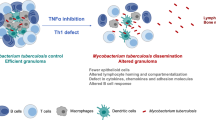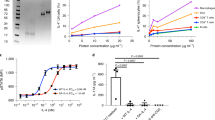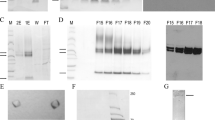Abstract
To increase the half-life of a cytokine and target its activation specifically to disease sites, we have engineered a latent cytokine using the latency-associated protein (LAP) of transforming growth factor-β1 (TGF-β1) fused via a matrix metalloproteinase (MMP) cleavage site to interferon (IFN)-β at either its N or C terminus. The configuration LAP-MMP-IFN-β resembles native TGF-β and lacks biological activity until cleaved by MMPs, whereas the configuration IFN-β-MMP-LAP is active. LAP provides for a disulfide-linked shell hindering interaction of the cytokine with its cellular receptors, conferring a very long half-life of 55 h in vivo. Mutations of the disulfide bonds in LAP abolish this latency. Samples of cerebrospinal fluid (CSF) or synovial fluid from patients with inflammatory diseases specifically activate the latent cytokine, whereas serum samples do not. Intramuscular injection in arthritic mice of plasmid DNA encoding these constructs demonstrated a greater therapeutic effect of the latent as compared to the active forms.
This is a preview of subscription content, access via your institution
Access options
Subscribe to this journal
Receive 12 print issues and online access
$209.00 per year
only $17.42 per issue
Buy this article
- Purchase on Springer Link
- Instant access to full article PDF
Prices may be subject to local taxes which are calculated during checkout





Similar content being viewed by others
Notes
*Note: In Figure 3b, the zero time point for IFN-LAP + RASF was omitted. This mistake has been corrected in the HTML version and will appear correctly in print. The correction has been appended to the PDF version available online.
References
Waldmann, T.A. & Tagaya, Y. The multifaceted regulation of IL-15 expression and the role of this cytokine in NK cell differentiation and host response to intracellular pathogens. Annu. Rev. Immunol. 17, 19–49 (1999).
Taniguchi, T. Regulation of cytokine gene expression. Annu. Rev. Immunol. 6, 439–464 (1988).
Taipale, J. & Keski-Oja, J. Growth factors in the extracellular matrix. FASEB J. 11, 51–59 (1997).
Khalil, N. TGF-β: from latent to active. Microbes Infect. 1, 1255–1263 (1999).
Aulitzky, W., Schuler, M., Peschel, C. & Huber, C. Interleukins: clinical pharmacology and therapeutic use. Drugs 48, 667–677 (1994).
Gutterman, J. Cytokine therapeutics: lessons from IFN α. Proc. Natl. Acad. Sci. USA 91, 1198–1205 (1994).
Golab, J. & Zagozdon, R. Antitumor effects of IL-12 in pre-clinical and early clinical studies. Int. J. Mol. Med. 3, 537–544 (1999).
Atkins, M. et al. High dose recombinant IL-2 therapy for patients with metastatic melanoma: analysis of 270 patients treated between 1985 and 1993. J. Clin. Oncol. 17, 2105–2116 (1999).
Margolin, K.A. Interleukin-2 in the treatment of renal cancer. Semin. Oncol. 27, 194–203 (2000).
Lode, H.N., Xiang, R., Becker, J.C., Gillies, S.D. & Reisfeld, R.A. Immunocytokines: a promising approach to cancer immunotherapy. Pharmacol. Ther. 80, 277–292 (1998).
Han, B., Hall, F.L. & Nimni, M.E. Refolding of a recombinant collagen-targeted TGF β 2 fusion protein expressed in E. coli. Protein Expr. Purif. 11, 169–178 (1997).
Gordon, E.M. et al. Capture and expansion of bone marrow-derived mesenchymal progenitor cells with a TGF β1-von Willebrand's factor fusion protein for retrovirus-mediated delivery of coagulation factor IX. Hum. Gene Ther. 8, 1385–1394 (1997).
Sanderson, N. et al. Hepatic expression of mature TGF-β1 in transgenic mice results in multiple tissue lesions. Proc. Natl. Acad. Sci. USA 92, 2572–2576 (1995).
Brunner, A. et al. Site-directed mutagenesis of glycosylation sites in the transforming growth factor-β 1 (TGF β 1) and TGF-β 2 (414) precursors and of cysteine residues within mature TGF β 1: effects on secretion and bioactivity. Mol. Endocrinol. 6, 1691–1700 (1992).
Brunner, A., Marquardt, H., Malacko, A., Lioubin, M. & Purchio, A. Site-directed mutagenesis of cysteine residues in the pro region of the TGF β 1 precursor. J. Biol. Chem. 264, 13660–13664 (1989).
Munger, J.S., Harpel, J.G., Giancotti, F.G. & Rifkin, D.B. Interactions between growth factors and integrins: latent forms of TGF-β are ligands for the integrin αVβ 1. Mol. Cell Biol. 9, 2627–2638 (1998).
Derynck, R. TGF-β-receptor-mediated signaling. TIBS 19, 548–553 (1994).
Saharinen, J., Taipale, J. & Keski-Oja, J. Association of the small latent TGF-β with an eight cysteine repeat of its binding protein LTBP-1. EMBO J. 15, 245–253 (1996).
Schultz-Cherry, S., Lawler, J. & Murphy-Ullrich, J.E. The Type 1 repeats of thrombospondin 1 activate latent TGF-β. J. Biol. Chem. 269, 26783–26788 (1994).
Crawford, S.E. et al. Thrombospondin-1 is a major activator of TGF-β 1 in vivo. Cell 93, 1159–1170 (1998).
Nunes, I., Gleizes, P.-E., Metz, C.N. & Rifkin, D.B. Latent TGF-β binding protein domains involved in activation and transglutaminase-dependent cross-linking of latent TGF-β. J. Cell Biol. 136, 1151–1163 (1997).
Kojima, S., Nara, K. & Rifkin, D.B. Requirement for transglutaminase in the activation of latent TGF-β in bovine endothelial cells. J. Cell Biol. 121, 439–448 (1993).
Yu, Q. & Stamenkovic, I. Cell surface-localized matrix metalloproteinase-9 proteolytically activates TGF-β and promotes tumor invasion and angiogenesis. Genes Dev. 14, 163–176 (2000).
Peng, K.-W., Morling, F.J., Cosset, F.-L., Murphy, G. & Russell, S.J. A gene delivery system activable by disease-associated matrix metalloproteinases. Hum. Gene Ther. 8, 729–738 (1997).
Ye, Q.Z., Johnson, L.L., Yu, A.E. & Hupe, D. Reconstructed 19 kDa catalytic domain of gelatinase A is an active proteinase. Biochemistry 34, 4702–4708 (1995).
Nagase, H. & Fields, G.B. Human matrix metalloproteinase specificity studies using collagen sequence-based synthetic peptides. Biopolymers 40, 399–416 (1996).
Saharinen, J., Hyyatiäinen, M., Taipale, J. & Keski-Oja, J. Latent TGF-β binding proteins (LTBPs)-structural extracellular matrix proteins for targeting TGF-β action. Cytokine Growth Factor Rev. 10, 99–117 (1999).
Goldman, M.H., James, D.C., Ison, A.P. & Bull, A.T. Monitoring proteolysis of recombinant human IFN-γ during batch culture of Chinese hamster ovary cells. Cytotechnology 23, 103–111 (1997).
Satoh, M., Hosoi, S., Miyaji, H., Itoh, S. & Sato, S. Stable production of recombinant pro-urokinase by human lymphoblastoid Namalwa KJM-1 cells: host-cell dependency of the expressed-protein stability. Cytotechnology 13, 79–88 (1993).
Masure, S. et al. Production and characterisation of recombinant active mouse gelatinase B from eukaryotic cells and in vivo effects after intravenous administration. Eur. J. Biochem. 244, 21–30 (1997).
Croxford, J.L. et al. Cytokine gene therapy in experimental allergic encephalomyelitis by injection of plasmid DNA-cationic liposome complex into the central nervous system. J. Immunol. 160, 5181–5187 (1998).
Triantaphyllopoulos, K.A., Williams, R.O., Tailor, H. & Chernajovsky, Y. Amelioration of collagen-induced arthritis and suppression of IFN-γ, IL-12, and TNF-α production by IF-β gene therapy. Arth. Rheum. 42, 90–99 (1999).
Karpusas, M. et al. The crystal structure of human IFN β at 2.2-Å resolution. Biochemistry 94, 11813–11818 (1997).
Massova, I., Fridman, R. & Mobashery, S. Structural insights into the catalytic domains of human matrix metalloprotease-2 and human matrix metalloprotease-9: implications for substrate specificities. J. Mol. Model. 3, 17–30 (1997).
Wakefield, L.M. et al. Recombinant latent TGF-β1 has a longer plasma half life in rats than active TGF-β1, and a different tissue distribution. J. Clin. Invest. 86, 1976–1984 (1990).
Pepinsky, R. et al. Improved pharmacokinetic properties of a polyethylene glycol-modified form of IFN-β-1-a with preserved in vitro bioactivity. J. Pharmacol. Exp. Ther. 297, 1059–1066 (2001).
Han, Z., Boyle, D.L., Manning, A.M. & Firestein, G.S. AP-1 and NF-κB regulation in rheumatoid arthritis and murine collagen-induced arthritis. Autoimmunity 28, 197–208 (1998).
van Meurs, J. et al. Cleavage of aggrecan at the Asn341-Phe342 site coincides with the initiation of collagen damage in murine antigen-induced arthritis: a pivotal role for stromelysin 1 in matrix metalloproteinase activity. Arth. Rheum. 42, 2074–2084 (1999).
Singer, I. et al. Aggrecanase and metalloproteinase-specific aggrecan neo-epitopes are induced in the articular cartilage of mice with collagen II-induced arthritis. Osteoarth. Cartil. 5, 407–418 (1997).
Kubota, E., Imamura, H., Kubota, T., Shibata, T. & Murakami, K. Interleukin 1β and stromelysin (MMP3) activity of synovial fluid as possible markers of osteoarthritis in the temporomandibular joint. J. Oral Maxillofac. Surg. 55, 20–27 (1997).
Louis, E. et al. Increased production of matrix metalloproteinase-3 and tissue inhibitor of metalloproteinase-1 by inflamed mucosa in inflammatory bowel disease. Clin. Exp. Immunol. 120, 241–246 (2000).
Baugh, M. et al. Matrix metalloproteinase levels are elevated in inflammatory bowel disease. Gastroenterology 117, 814–822 (1999).
Leppert, D. et al. Matrix metalloproteinase-9 (gelatinase B) is selectively elevated in CSF during relapses and stable phases of multiple sclerosis. Brain 121, 2327–2334 (1998).
Anthony, D.C. et al. Differential matrix metalloproteinase expression in cases of multiple sclerosis and stroke. Neuropath. Appl. Neurobiol. 23, 406–415 (1997).
Libby, P. The interface of atherosclerosis and thrombosis: basic mechanisms. Vasc. Med. 3, 225–229 (1998).
DeClerck, Y.A. et al. Inhibition of invasion and metastasis in cells transfected with an inhibitor of metalloproteinases. Cancer Res. 52, 701–708 (1992).
Wakefield, L. et al. Recombinant TGF-β1 is synthesized as a two-component latent complex that shares some structural features with the native platelet latent TGF-β1 complex. Growth Factors 1, 203–218 (1989).
Vodovotz, Y. et al. Regulation of TGF β1 by nitric oxide. Cancer Res. 59, 2142–2149 (1999).
Chernajovsky, Y., Adams, G., Triantaphyllopoulos, K., Ledda, M.F. & Podhajcer, O.L. Pathogenic lymphoid cells engineered to express TGF β1 ameliorate disease in a collagen-induced arthritis model. Gene Ther. 4, 553–559 (1997).
Triantaphyllopoulos, K., Croxford, J.L., Baker, D. & Chernajovsky, Y. Cloning and expression of murine IFN β and a TNF α antagonist for retrovirus gene therapy of experimental allergic encephalomyelitis. Gene Ther. 5, 253–263 (1998).
Chernajovsky, Y. et al. Efficient constitutive production of human fibroblast interferon by hamster cells transformed with the IFN-β 1 gene fused to an SV40 early promoter. DNA 3, 297–308 (1984).
Ogata, Y., Itoh, Y. & Nagase, H. Steps involved in activation of the pro-matrix metalloprotease 9 (progelatinase B)-tissue inhibitor of metalloproteinases-1 complex by 4-aminophenylmercuric acetate and proteinases. J. Biol. Chem. 270, 18506–18511 (1995).
Dreja, H., Annenkov, A. & Chernajovsky, Y. A novel truncated form of human soluble complement receptor 1 delivered by gene therapy prevents and ameliorates collagen-induced arthritis by inhibiting B and T cell responses. Arth. Rheum. 43, 1698–1709 (2000).
Acknowledgements
This work was funded by the Multiple Sclerosis Society of Great Britain and Northern Ireland, the Arthritis Research Campaign (UK) and Kinetique Biomedical Research Seed Fund UK. We thank Irene Theoharidou for her expert secretarial assistance, G. Scott and G. Giovannoni for clinical samples, S. Amor for samples from rhesus monkeys, S. Mather and D. Ellison for help with protein iodination, J. Wilson and A. Mustafa for technical help, A. Johnston for the analysis of pharmacokinetic data, L. Layward, D. Willoughby, O.L. Podhajcer and P. Colville-Nash for reviewing the manuscript and H. Nagase for helpful and encouraging discussions.
Author information
Authors and Affiliations
Corresponding author
Ethics declarations
Competing interests
G.A., H.D. and Y.C. are shareholders in Stealtnyx Therapeutics, Ltd., which holds patents based on this technology.
Rights and permissions
About this article
Cite this article
Adams, G., Vessillier, S., Dreja, H. et al. Targeting cytokines to inflammation sites. Nat Biotechnol 21, 1314–1320 (2003). https://doi.org/10.1038/nbt888
Received:
Accepted:
Published:
Issue Date:
DOI: https://doi.org/10.1038/nbt888
This article is cited by
-
Masking the immunotoxicity of interleukin-12 by fusing it with a domain of its receptor via a tumour-protease-cleavable linker
Nature Biomedical Engineering (2022)
-
Development of latent Interferon alpha 2b as a safe therapeutic for treatment of Hepatitis C virus infection
Scientific Reports (2019)
-
Selective antibody activation through protease-activated pro-antibodies that mask binding sites with inhibitory domains
Scientific Reports (2017)
-
Targeting of viral interleukin-10 with an antibody fragment specific to damaged arthritic cartilage improves its therapeutic potency
Arthritis Research & Therapy (2014)
-
Library-based selection of retroviruses selectively spreading through matrix metalloprotease-positive cells
Gene Therapy (2005)



